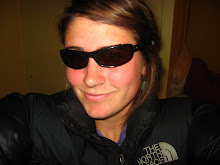Stretching some 400km x100km the sand dunes of the Namib-Naukluft National Park stand as a good reminder of the power of nature. Yesterday Peter and I accompanied by my roommate and friend Dylan (a girl) spent the day traveling by Yamaha 4x4s known to us as dune buggies, to the remote location of Sandwich Harbour. Sandwich Harbour is located some 70km from Walvis Bay our port town and accessible only via beach and dunes. We had two dunes buggies for the three of us and our outstanding guide Moses. Peter and Dylan took turns driving one and I took the passenger seat in Moses buggy and drilled him with questions about the fascinating natural history of Namibia as well as getting his take on southern African politics. For a young African man from a rural village and no university education he was wise beyond his years. By the end of our day with him I was both totally mesmerized by the intricate workings of mother natural as well as plagued with a killer head ache from all that my brain had absorbed (information and direct sunlight) over the last 9 hours. I can only hope that in some form I can try to transcribe some of what had me totally captured.
First it is necessary to imagine glaciers in Africa, which in 100-degree heat wasn’t easy for us. These glaciers that are of importance for the sake of my story were once located in what is now the Kalahari Desert located in today’s Botswana and the northern part of South Africa. With the recession of these glaciers the massive sandstone the existed underneath slowly was ground down into sand. In the form of sand it was then blown and washed into the Orange River basin and carried all the way out to the rives mouth at the Atlantic coast. Here the sand built up and was then blow north by the Beguiles (sp?) Current, thus beginning its build up along the Namibian coast.
Little life is apt for such a climate but the few flora and fauna that have managed to survive have made vital adaptations that enable their survival. Ants and beetles have adapted by having longer legs that allows them to be even a millimeter more removed from the scorching sand. It is said that this millimeter can decrease the temperature exponentially. You find little vegetation that has learned to retain well the precious water that falls infrequently on the dessert. One of these plants is the !nara, pronounced with a click of the koikoi language. The !nara comes in both female and male plants, the female ones produce a potent fruit. The pollination uses the wind to spread the love. This plant is so well conditioned for such a desolate place we were able to see a 500 year old !nara plant that had roots that stretched some 40-50 meters. The age can be determined by movement of the dunes (it is estimated that the dunes move roughly 10cm a year) that in turn exposes the roots. Not entirely sure on the processes but Moses seems confident on the aging.
These dunes offered something entirely different that my previous experiences with the profundity of nature. I don’t know if its the absence of “vegetation clutter“ if you will that leaves you with a quite simple beauty of the yellow sand and blue sky or if it is the unfathomable fact that these mammoth dunes that span as far as the eyes can see are made up of itsy-bitsy particles of sand but I do know that I was entranced in a way that I haven’t been before. So utterly impressed with yet another earthly phenomenon that seems so…out of this world.
Subscribe to:
Post Comments (Atom)

No comments:
Post a Comment